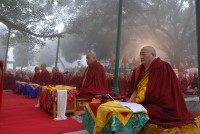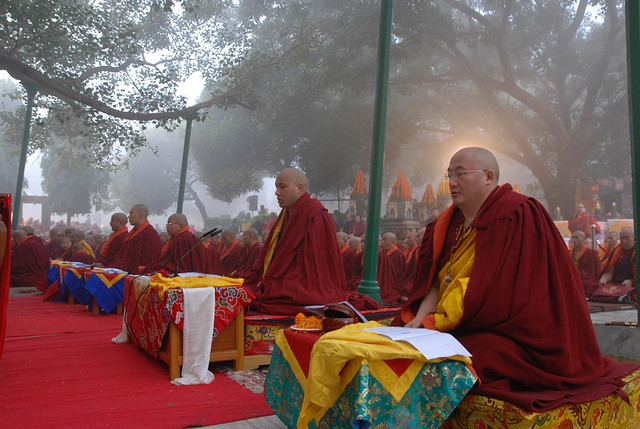法王新闻 | 2009年01月
『第26屆噶舉祈願法會』第一天日誌
『26th Kagyu Monlam』Day 1
時間:2009年01月04日 Saturday January 04, 2009
地點:印度 菩提加耶
報導:黃靖雅
攝影:噶瑪善治、噶瑪諾布
授八關齋戒 並從密勒日巴故事 說信心與法器
相信祈願的力量,相信全世界的和平與幸福,可以從一念純淨的祈願開始,當善願匯聚成海,「以善轉動世界」的力量就啟動了──這是「噶舉大祈願法會」邁入第26屆的信念。何況這善願行動,是在佛弟子都相信 「善業功德成億萬倍成長」的聖地:菩提迦耶。
清晨五點半,世俗的菩提迦耶尚未甦醒,四周一片黑暗,行者幾乎看不見腳下的路,近乎零度的氣溫,人人動靜之間呵氣成白霧,著名的菩提樹上濃重的露水時而落下,讓人以為乾季的菩提迦耶紛紛下起了奇蹟的 雨。
參加「第26屆噶舉大祈願法會」的上萬僧俗二眾,早已經坐在菩提大塔旁的位置上,面對著佛陀成道的金剛座,準備迎接法王前來主法,展開為期八天(1/4~1/11)念誦祈願文,為世界和平和眾生幸福祈願 的菩薩行。

第一座法,法王傳授「八關齋戒」
6:00,清晨曉霧中,噶舉傳承持有者第十七世法王 鄔金欽列多傑,在萬眾敬候中蒞臨,在佛陀降魔成道的菩提樹下、金剛座前,陞座主法。隨同法王出席的大仁波切,有蔣貢康楚仁波切、嘉察仁波切、 蘇曼 噶旺仁波切、創古仁波切、卡盧仁波切、明就仁波切、竹奔德千仁波切。
法王首先傳授漢傳通稱「八關齋戒」的「大乘布薩戒」,帶領大眾念誦戒文三次,發願依戒持守一日夜清淨行,過午不食、不臥高廣大床、不伎樂歌舞、不塗香莊嚴等,至次日日出之前還淨,可累積資糧、淨除障 礙,以此清淨身心作祈願,更具利他之力用。
法王在授與在場的僧眾大乘布薩戒後,給了一段簡短的開示。法王說,大家來到此地,最重要的是要持守善的動機,時時刻刻都要保有身、語、意的良善。如果你來到了這裡,卻還是有和平常一樣的行為與思維的 話,那麼,即使是在聖地,也不會得到太多的利益。這一切都取決於你個人的行為舉止,我實在也無法說得再多了。
之後,大眾以梵、藏二文念誦「三常誦」、「皈依發心」、「祈願儀軌二十支」。
26th Kagyu Monlam Chenmo began with a quiet thick, damp fog blanketed all over Bodh Gaya. At 5 am the participants proceeded to the Mahabodhi Stupa, only gradually did their forms emerge from the silent mist. The closer to the Stupa they came, the greater were their numbers, until monks, nuns and laypeople from all parts of the world came streaming through the great gates of the Stupa complex and began their circumambulation of the ancient site, murmuring mantras and prayers. An electricity cut made the early morning seem even more mystical, and the reduced lighting caused the Stupa to appear floating in space and insubstantial.
Beneath the Bodhi Tree, devotees found their way to their seats and sat waiting expectantly for the arrival of His Holiness Gyalwang Karmapa, Jamgon Rinpoche, Gyaltsab Rinpoche, Thrangu Rinpoche, Kalu Rinpoche, Mingyur Rinpoche and other high lamas. Fragrant incense wafted in the air, every stupa, wall and railing was decorated with strings of marigolds, and the Kagyu Monlam Shrine stretched resplendently across the front of the assembly against a background of draping yellow and blue cloth. Monks and nuns donned their yellow robes and sat quietly, the disciplinarians guided people and organized proceedings, the laypeople found their way to their designated seating.
Finally, the police siren heralded the imminent arrival of His Holiness, who made his way to the inner circuit and took his place beneath the Bodhi Tree at a small brocaded table to bestow the Sojong Vows. He spoke about motivation and the purpose of the Kagyu Monlam, and about the need to keep clearly in mind the suffering beings of the whole world, including animals, and to generate a pure wish to liberate them from suffering and bring peace to the world. He said that to participate in the Kagyu Monlam with such a great intention would really be a useful endeavour.
Morning prayers then began with the sonorous chanting of the Refuge Prayer in Sanskrit, followed by the Heart Sutra and verses of the Buddha’s words:
Do not do even one misdeed; Conduct yourself with utmost virtue. Tame your own mind completely, too. This is the teaching of the Buddha.
Like stars, or seeing spots, or candles, Or like illusions, dewdrops, bubbles, Like dreams or lightning or else clouds, View all composites in this way.
By this merit may omniscience be attained, Defeating the enemy, wrongdoing. May all be liberated from the ocean of samsara, Turbulent with the waves of birth, aging, sickness and death.
Then began the chanting of the Twenty Branches of the Monlam, composed by the Seventh Gyalwang Karmapa, Chodrak Gyatso, and revised by His Holiness. As the voices of the participants rose into the dawn sky, birds began to sing in the Bodhi Tree, and a great wave of energy filled the space. Steaming pots of Tibetan tea and sweet saffron rice were served to celebrate the auspicious occasion. The 26th Kagyu Monlam had begun.
第二座法,法王說「密勒日巴大師傳」
9:00,法王再次陞座,繼續去年主題,開示噶舉黃金念珠傳承上,以住山苦修而「即此一生成就佛果」的感人祖師:密勒日巴大師的傳記。
今年首日,故事本身說到,密勒日巴歷經造塔等馬爾巴大師的種種嚴苛考驗,仍未獲大師同意傳法,自感罪業深重,想去自殺,馬爾巴大師深自嘆息後說:「大力我兒,能在種種嚴苛考驗中,對三寶、上師不生邪 見,是具足大信心的真法器。需知上師示現憤怒相,是上師利眾事業的示現,是為淨除弟子罪障,切不可以世俗之見觀之。本來大力(即密勒日巴)在歷經九次大苦行之後,即可罪障清淨、不受後有,現在如有殘餘的 罪障未淨,皆是師母達媚瑪女人心軟之故。」即予口傳、灌頂,並作種種授記。
During the second session of the first day of the 26th Kagyu Monlam, Gyalwang Karmapa resumed his transmission of The Songs of Milarepa. He began by reading the third chapter which tells how, after years of difficulties and hardships, Marpa finally accepted Milarepa as his student. Milarepa prostrated and wept with joy. Marpa gave him the Refuge Vows, cut his hair, gave him the Bodhisattva Vow, and promised to instruct him.
法王根據此段故事,開示「上師與弟子」之間應有的信心和三昧耶,「上師有不同的行儀和示現,不生邪見,才是俱足信心。」祖師密勒日巴的故事,正好可以做為修行人的借鑑。
法王說,釋迦牟尼佛利益後世,要藉上師才能行佛事業,我們要多學習馬爾巴與密勒日巴的師徒關係,兩位大師的口訣,今天讀起來,仍覺得「熱呼呼」的呢。
His Holiness drew on this story to talk about the lama-student relationship. The first lesson from the story was that through all those hardships imposed on him by Marpa, Milarepa had never given up on his teacher. As followers of the Kagyu lineage, we should follow the example of the great lineage masters.
六大祖師多瑪、石頭壇城、祈願詩文牆的意義接著,法王開示,今年法會現場裝置了噶舉傳承的馬爾巴、密勒日巴、岡波巴,以及薩迦、寧瑪、魯格三大教派六大祖師的多瑪,「我們不只要禮敬根本傳承上師的恩德,也要禮敬一切教派上師,」因為藏地各教 派都有交流、源流都是相通的。「我們不只要禮敬見過的上師,也要心量廣大的禮敬各宗派無別的一切上師。」這就是今年「四大教派無分別多瑪」的意義。今年的供養壇由韓國信眾負責,呈現濃厚的韓國風味。
Pointing out the six great tormas to his left and right, His Holiness explained that this year there was a break with tradition. The tormas on his right were representations of the great Kagyu lineage masters Marpa, Milarepa and Gampopa, but the ones on his left represented the other great lineages of Tibetan Buddhism, Nyingmapa, Sakyapa, and the Gadenpa (founders of the Gelukpa tradition). His Holiness gave a potted history of the development of the different lineages in Tibetan Buddhism and then reminded everybody that although there were differences between these traditions, with slight differences in instructions and emphasis, we should remember that basically they were interlinked, and often mixed up together. The tormas were a reminder of the width of the Buddhist lineage, not just decorations.
法王說,今年法會供奉了一座「石頭壇城」,這是最新的,這些石頭來自全球五大洲,包括伊拉克、克羅埃西亞、巴基斯坦等地,甚至包括月球,我們要把這些經過法會加持的石頭,再送回世界各角落、但不必送 回原處,代表把對「世界和平、眾生幸福」的祈願,送到全球各地。
法王提及,今年大門口還裝置了「祈願詩文牆」,這也是最新的,代表來自世界各地的心聲,有些是藏人所寫,有為和平、為環保、為父母、為動物等不同主題所寫的詩文。「了解有情的心願,祈願才更有力」, 想對眾生生起難忍的大悲,要能感受到眾生的苦,希望大家慈愛之心互約,這個詩文牆,就是讓祈願者聽見世界的聲音。


接著,法王請大眾唱《密勒日巴大師傳》中,關於密勒日巴這段故事的道歌(大眾在維那師領唱下,以藏文唱頌)──
敬禮譯師馬爾巴前,遠離言說祈加持﹔
為有上師加持力,此心不受動搖害。
恆修慈愛與悲憫,遂忘自他之執著。
頂載上師恆修觀,遂忘威勢之官府。
不離本尊而修觀,遂忘卑小蘊、界、處。
思維耳傳之口訣,遂忘文字與經典。
守護本來平常心,遂忘無明之誤謬。
自身觀作佛三身,遂忘希冀與畏怖。
此生來生平等觀,遂忘死生之恐懼。
護持證解獨自居,遂忘親朋之照顧。
一心定慧之進益,遂忘宗派之異同。
思維生滅皆無實,遂忘教義宗派見。
思維現象皆法身,遂忘著相之修觀。
無整寬坦而安住,遂忘世間禮儀行。
身語歸住於下位,遂忘富貴之驕淫。
以此幻身作我廟,遂忘各自宗派寺。
言語道斷為作證,遂忘詮表解說義。
言詮義語君能說,請君勿為法所執!
Referring back again to the story, he said that Marpa had no personal motive in giving Mila such a hard time. His actions could be misunderstood, but were in fact buddha activities, not something wrong or unskilfull. As to our own lamas, apart from our own teacher we had many different lamas – our root lama, lineage lamas, and so forth, therefore, even if guru yoga was part of our practice, we should also recite the lineage prayer because it referred to many lamas from different schools with whom we had a connection. Remembering this would prevent disunity and fragmentation. We enter into the Buddhist path to work for the benefit of beings without partisanship.
The first requirement of a student was devotion and confidence in their root lama and the lineage lamas. The second requirement was study and practice. The life of Milarepa was more than a story. We needed to study it, understand it, and then put the lessons from it into action. We read the story in order to understand how the dharma was actualized in Milarepa’s life.
His Holiness then moved on to other special features of this year’s Monlam. The mandala containing stones from all over the world was very appropriate when the purpose of the Monlam was to pray for world peace and the welfare of the peoples of the world.
禪修,不想過去、不想未來,安住當下一念之明覺接著,法王帶領大眾禪修。「我們是噶舉修傳派的人,應該都知道禪修的身要吧」,但法王還是再簡略說了一次禪修的身要,為了「讓心如箭」,強而有力的射向前方,我們應不昏沈不散亂,我們修習「七支坐法」 ──
一 身正:「身正,則心正」。
二 金剛跏趺坐:就是雙盤,採單盤「菩薩坐」亦可。
三 背脊挺直:法王提醒,冬日天寒,大家又裏在暖暖的大袍裡,如果彎著身體,很容易就睡著了,要挺直,才不昏沈;但也不能太直,易散亂。
四 微收下顎。
五 兩肩自然下垂,頭穩穩的放在頸子上。
六 兩眼自然垂視鼻尖,但不要太用力看。
七 兩手結禪定印,右上左下交扣。
以上是「身要」。法王接著說:「心要方面,有很多不同的修法,以心為所緣,容易開發神通。現在,讓心放輕鬆,不想過去,不想未來,就安住在當下一念的心中,安住在那一念清晰、覺照的心,這就樣禪修五 分鐘。」
大眾禪修五分鐘之後,法王半開玩笑的提醒:「不要把禪修和打瞌睡搞混了,我們是修傳派的人,才坐五分鐘就彎著打瞌睡,這樣太丟臉,我本來還想讓大家坐十分鐘,我看明天還是五分鐘好了,免得都倒下來。」
接著,法王獨誦〈大祈願文〉(大祈願課誦本P242)、〈冥陽迴向文〉(大祈願課誦本P260,法王獨誦,大眾諦聽,至自己名與往生者名時,才稱名)。
第三座法,普賢行願品與慈氏願文
下午:1:30,念誦開始。念誦的經文為《華嚴經》中的〈普賢行願品〉與《大寶積經》中的〈慈氏願文〉。
法王在兩部經文的第一次念誦過後,均對其內容涵義簡短地予以開示。法王說道,普賢菩薩是一切諸佛菩薩共同的名字;〈普賢行願品〉為普賢菩薩所宣說的願文﹐內容可分為兩部分﹕前行與願文。前行的內容 為得以清淨自心的「七支供養」。在「我隨一切如來學」後的經文是正文,其內容是宣說普賢菩薩供養如來、行佛事業等等的十個大願。
在這些偈文中,法王特別地提出了針對僧眾、在家眾、與僧俗二眾都適用的三個偈文。對於僧眾而言,很重要的偈文為──
所有與我同行者,於一切處同集會,
身口意業皆同等,一切行願同修學。
法王說,因為同是修學者,消融彼此之間的差異與爭端是很重要的。
對於在家眾而言重要的偈文為──
彼佛眾會咸清淨,我時於勝蓮華生,
親睹如來無量光,現前授我菩提記。
做為一位在家居士,修行的時間往往很少,所以發願往生極樂淨土以免墮入三惡道之苦是極為重要的。
對於僧俗二眾都重要的偈文為
文殊師利勇猛智,普賢慧行亦復然,
我今迴向諸善根,隨彼一切常修學。
即使我們一時無法在行誼上完全符合經文所談論到的內容,但是也應當奉行與自身心意相合的部份。在目前到處都充滿了污染的世界,我們可以運用科學的知識與方法來對治污染保護環境。類似地,我們在行為上 也應當與祖師大德的行誼相符合。我們不僅僅是念誦經文時具備有這樣的意樂之心,在下座後仍然需要有保有這樣的意樂之心。否則,不但不可能興盛佛法,也無法利益到眾生。
至於對於《慈氏願文》的開示,法王說道昔日彌勒菩薩在修行時,曾布施眼目、腦髓,由此可知菩薩的行誼不可思議,而且是不會有相衝突之處。
此經文先由彌勒菩薩的積資淨障開始宣說,然後迴向往昔所有善根成為菩提的因,進而發出行菩提心的願心,接著行六度波羅蜜。念誦這部經文的重點,是應以了知空性的義理來做這樣的祈願,發願自身也能像彌 勒菩薩一樣,成為一位安住在十地頂嚴的菩薩。
第四座法
下午3:30,維那師帶領大眾念誦下列願文──
〈實語成就之般若尼達入遍智城〉(大祈願課誦本P380)、
〈祝禱有情福樂文〉(大祈願課誦本P384)、
〈菩提道次第祈願文〉(大祈願課誦本P389)、
〈無分別持教長壽願文〉(大祈願課誦本P380)、
〈長壽願文〉(見長壽文本)、
〈護法供儀〉(中文無)、
〈雪域安樂願文〉((大祈願課誦本P460)、
〈天子所問吉祥文偈〉(大祈願課誦本P291)、
《月藏經》(大祈願課誦本P269)
